Under the effects of climate change, the Sonoran Desert is expected to become hotter and drier. These changes are likely to have strong impacts on the abundance and distribution of the region's plant species. A recent study used long-term vegetation monitoring results across two national parks and two research sites to determine how Sonoran Desert plant species have responded to past climate variability.
Reduced annual precipitation would result in reduced soil moisture in an already water-limited environment (Seager et al. 2007). Drought-tolerant species may show no change or even increase in abundance, while species without drought-survival mechanisms may decrease or experience high mortality.
A shift in the seasonality of precipitation may also influence plant performance. Summer precipitation produces shallow soil moisture utilized by plant species with shallow roots, whereas winter precipitation percolates deep into the soil profile and is utilized by deeply rooted vegetation. Increasing temperatures can increase evaporative demand, thereby limiting plant water availability and, in turn, plant growth and survival. Higher temperatures may also increase the distribution and productivity of many cold-intolerant desert plants, including succulents.
Methods
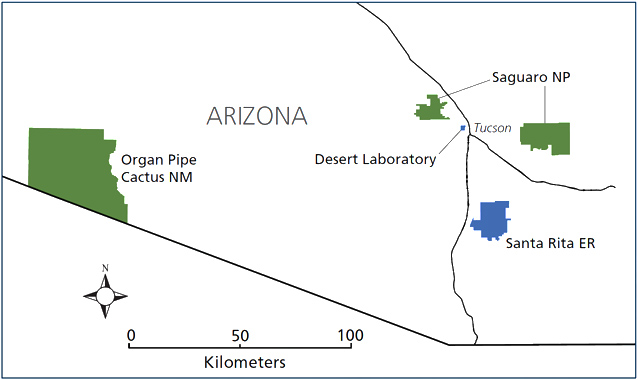
Because climate change and its impacts are occurring at regional scales, forecasting future shifts in plant community composition, structure, and productivity requires a regional-scale assessment of plant species response to recent climate variability. To complete such an assessment, scientists from the National Park Service and U.S. Geological Survey used long-term (100 years) vegetation monitoring results from 39 large (≥100-sq-m) plots in three different plant communities across two Sonoran Desert national parks (Saguaro NP and Organ Pipe Cactus NM) and two long-term research sites (the Desert Laboratory and Santa Rita Experimental Range) to determine how plant species have responded to past climate variability at a regional scale (Figure 1). To quantify plant responses, we measured the change in cover of plant species between vegetation sampling years. A positive value of this index indicated that a plant species gained cover over the observation interval, while a negative value indicated that it lost cover.
Specific objectives were to: (1) determine which plant species and functional types in the Sonoran Desert region are most sensitive to climate change, (2) identify climate thresholds that are indicative of changes in plant abundance, and (3) document the magnitude of plant responses that have occurred over a regional climate gradient.
Mesquite Savanna
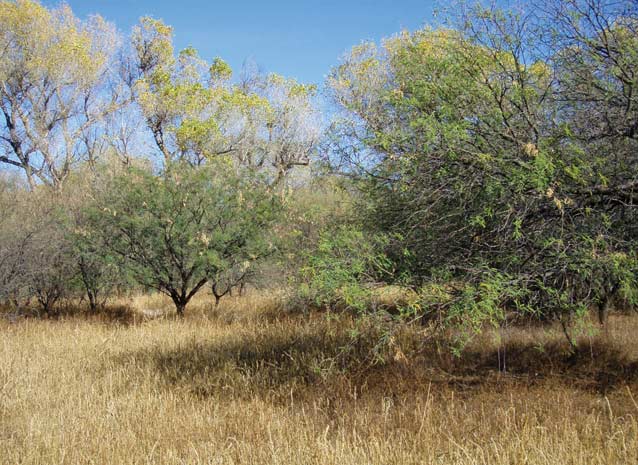
Photo by Sarah Studd, NPS
In the relatively mesic mesquite savanna communities, perennial grasses (Figure A) and forbs (Figure B) both declined with a decrease in annual and winter precipitation, respectively. Perennial grasses and forbs likely showed large responses to precipitation because they are fast-growing and shallow-rooted. Perennial grass cover decreased when annual precipitation dipped below 390 mm; this amount of water input may indicate a threshold that limits perennial grass performance in the Sonoran Desert. Because forbs account for most species in the community, winter precipitation has important implications for species diversity.
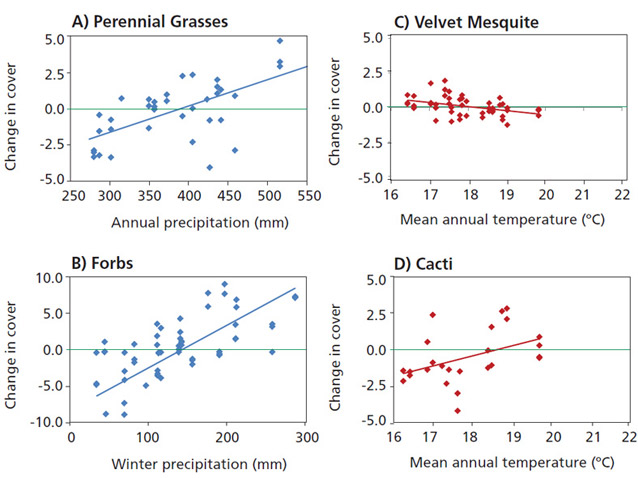
In response to increasing mean annual temperature (MAT), there was a reversal of the velvet mesquite (Prosopis velutina) expansion seen in the twentieth century (Figure C). These results suggest that a threshold MAT near 18°C may cause significant stress on velvet mesquite by increasing evapotranspiration rates, especially in years with low precipitation or in upland settings.
Cacti cover increased with increasing temperature, a trend that has been documented across the southwestern U.S. (Figure D). This trend of increasing temperature was associated with a decreased frequency of extreme freezes, providing less potential for tissue damage and mortality of succulents that store water.
Arizona Upland (Sonoran Desertscrub)
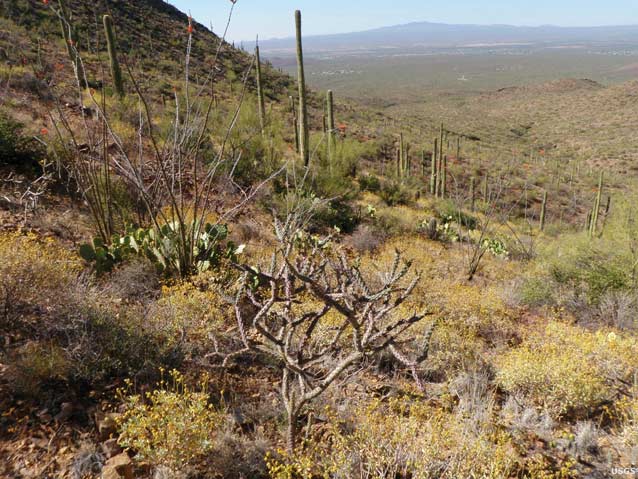
Photo by Sarah Studd, NPS
In the drier Arizona Upland communities, the dominant leguminous tree, foothill paloverde (Cercidium microphyllum), declined on hillslopes in response to increasing MAT (Figure E). Previous research (Bowers and Turner 2001) has documented high mortality of the largest trees under conditions of increased temperature and decreased water availability, suggesting that such periods likely have the greatest infl uence on older, senescing trees.
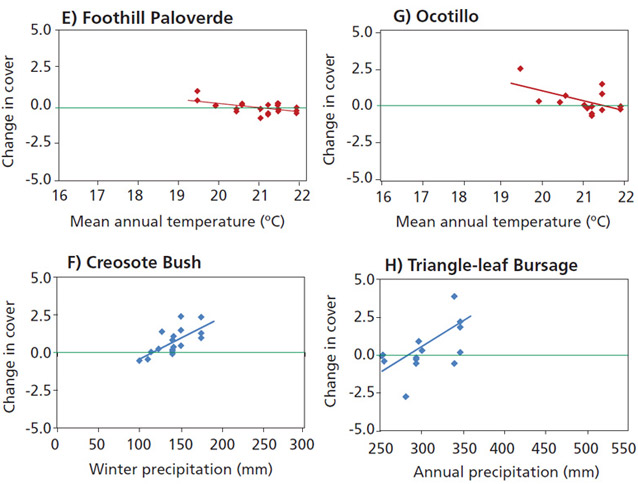
The cover of creosote bush (Larrea tridentata), significantly correlated to winter precipitation, began to decline with a drop below 110 mm (Figure F).
Ocotillo (Fouquieria splendens), a semi-succulent shrub, decreased on south- and west-facing slopes in response to increasing MAT (Figure G). In these landscape positions, seedling recruitment is low and roots can be susceptible to direct heat damage and low water availability when temperatures are high.
The drought-deciduous triangle-leaf bursage (Ambrosia deltoidea), which serves as a nurse plant for many woody species in the Sonoran Desert, showed large fl uctuations in cover in response to shifts in annual precipitation (Figure H). Cover for this facilitative species increased with more than 290 mm of annual precipitation, which may indicate an important potential threshold for new recruitment in this region.
Creosote Bush Shrublands
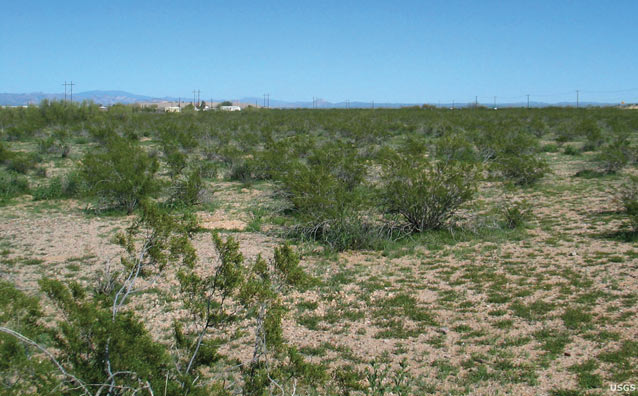
Photo by Sarah Studd, NPS
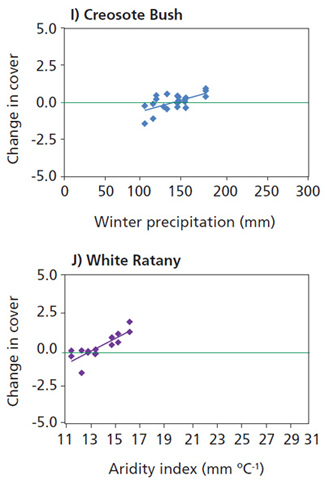
In one of the driest Sonoran Desert plant communities, the co-dominant species creosote bush and its hemiparasite, white ratany (Krameria grayi), decreased with a decrease in winter precipitation and increased aridity, respectively (Figures I and J). There were more declines in cover of creosote bush and a higher winter precipitation threshold (135 mm) for the shrub in communities where it was dominant than in Arizona Uplands (see Figure F). The decline of creosote bush was only evident on old soil surfaces, which have restrictive layers, including petrocalcic horizons. These layers may limit the soil volume available to plant roots and restrict water infi ltration, holding water at shallow depths where it is more susceptible to evaporation at high temperatures.
Conclusions
Over the last 100 years, many plant species and functional types across the Sonoran Desert have responded to increasing temperatures and drought conditions, which are predicted for the future. Decreases in abundance of dominant Sonoran Desert plant species, including velvet mesquite, foothill paloverde, and ocotillo, occurred in years with high temperatures. High temperatures may have directly influenced plant growth or indirectly influenced water availability through evapotranspiration losses. Other dominants, including creosote bush, were most sensitive to decreases in precipitation, especially in winter months. The regional scale at which climate change and its impacts to plant community composition are occurring requires that we broaden our focus from assessing plant responses at the park scale to understanding plant dynamics at a large spatial scale. While this analysis showed historical relationships between climate and vegetation, the NPS I&M program is well positioned to address future changes in vegetation caused by climate change at regional scales.
Additional Information
For more information, see the full journal article:
Munson, S. M., R. H. Webb, J. Belnap, J. A. Hubbard, D. E. Swann, and S. Rutman. 2011. Forecasting climate change impacts to plant community composition in the Sonoran Desert region. Global Change Biology. Published online December 30 at http://onlinelibrary.wiley.com/doi/10.1111/ j.1365-2486.2011.02598.x/abstract.
or contact Seth Munson (smunson@usgs.gov). This work was supported by the National Park Service and a grant from the U.S. Geological Survey Status and Trends of Biological Resources Program.
References
Bowers, J. E., and R. M. Turner. 2001. Dieback and episodic mortality of Cercidium microphyllum (foothill paloverde), dominant Sonoran Desert tree. Journal of the Torrey Botanical Society 128:128–140.
Seager, R., M. Ting, I. Held, et al. 2007. Model projections of an imminent transition to a more arid climate in Southwestern North America. Science 316:1181–1184.
Prepared by the Sonoran Desert Network, 2012.
Last updated: January 28, 2021
